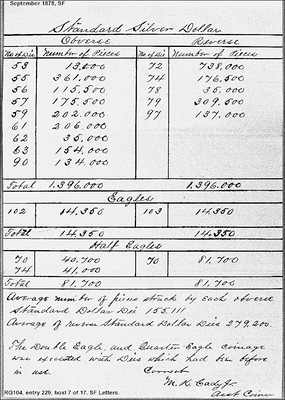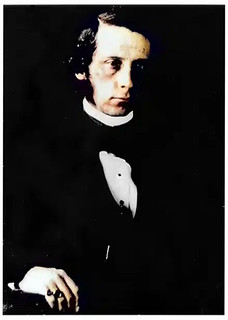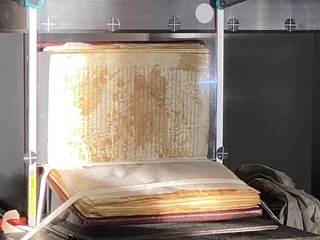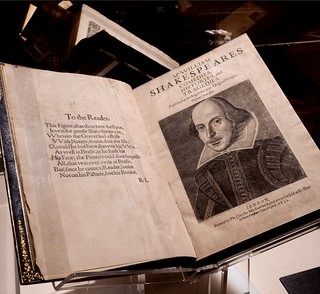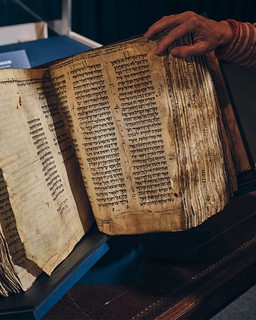
PREV ARTICLE
NEXT ARTICLE
FULL ISSUE
PREV FULL ISSUE
LOOSE CHANGE: MAY 14, 2023Here are some additional items in the media this week that may be of interest. -Editor Researcher Roger Burdette published an interesting article on CoinWeek on how U.S. coin dies came to be numbered for identification. Here's a short excerpt - see the complete article online for much more. Great example of the new information found in the National Archives, as discussed a few weeks ago. -Editor
Engraver James B. Longacre was the first to officially imply that dies be numbered or otherwise marked so that a record could be kept. The basic purpose was to ensure that all dies got to the correct mint, and that the engraver had a list of dies made from his hubs and master dies. At the end of the calendar year, each mint reported the quantity of dies destroyed by denomination. This was supposed to match production and distribution records kept by the Engraving Department. By 1878, coinage dies were being numbered – likely consecutively as they were completed and ready for use, although at present we don't have explicit documentation. In September 1880, Mint director Horatio Burchard wrote to Philadelphia Mint Superintendent Snowden with suggestions for tighter control of dies. It's not obvious why this change was made, but a possible reason is to keep better track of the large quantities of silver dollar dies being sent to all the branch mints each year. Adding numbers to dies by order of production for each facility would have made data recording easier, and simplified reporting.
To read the complete article, see:
To read the earlier E-Sylum article, see:
Roger Burdette discusses what seems today as a very bizarre 1859 distribution of freshly minted quarters to a group of slaves by Pierce M. Butler, whose other numismatic connection is serving as an Assay Commissioner. See the complete article on CoinWeek. -Editor
In 1858 he was selected by the president of the United States to serve on the government's annual Assay Commission of U.S. coins at the Philadelphia Mint and was present for the coinage trials. There's no record of him doing anything during the Commission's meetings, but that was not unusual for the time. In March 1859, creditors brought to sale all of the slaves from Butler's plantations. These were sold over a two-day period at the Ten Broeck, a race track near Savannah, GA. After the sale, in appreciation of their work and devotion to him, Pierce M. Butler personally presented – in his gloved hand, of course – each freshly sold slave four new quarter dollars – one dollar in silver, total. These coins had been procured fresh from the U.S. Mint in Philadelphia and sat in two canvas bags of $500 each on a table next to the former owner.
To read the complete article, see:
Here are a few items for bibliophiles. Len Augsburger passed along this article about a long-lost ancient manuscript. Thanks. -Editor
After years of painstaking work, the team, from the Sorbonne and New York Universities, have deciphered the long-lost message detailing the construction and uses of an ancient tool for tracing distances and the stars. "The pages in the manuscript with the scarcely visible Greek text were discovered back in 1819 by Angelo Mai, but he was unable to read most of the pages," Alexander Jones, one of the lead researchers on the study, told Newsweek. "[He also] made the situation much worse for subsequent scholars by applying a chemical treatment to the pages that was supposed to bring out the writing but in fact just stained them dark brown." In January 2020, the team began analyzing the manuscript in detail, using multispectral imaging techniques to reveal the hidden ink. The parchment on which the manuscript had been written was found in the library of the Bobbio Abbey in Italy and is now stored at the Biblioteca Ambrosiana in Milan. "The monks of the Bobbio Abbey, where our manuscript comes from, were great recyclers of pages from disused books since parchment was always very expensive," Jones said.
To read the complete article, see:
Pat McBride passed along this announcement, noting "In case any bibliophiles want to make a side trip during the August ANA World's Fair of Money." -Editor
To read the complete article, see:
The Wall Street Journal published an article about what might soon be the world's most valuable book. -Editor
She understood better than anybody that this wasn't just any copy of the Hebrew Bible. It was the earliest, most complete Hebrew Bible known to exist. This roughly 1,100-year-old treasure belongs to Jaqui Safra, a financier who kept the antiquity in his collection for decades, and he wanted to put it in the hands of the pre-eminent Judaica specialist at Sotheby's. The fingerprints of Ms. Mintz can be found all over the auction next week that could make this sacred text worth more than any book or manuscript ever sold. Sotheby's is hoping the most precious Hebrew Bible in private hands fetches between $30 million and $50 million. At the high end, that would exceed the $43.2 million price tag on a rare copy of the U.S. Constitution auctioned in 2021.
To read the complete article (subscription required), see:
Wayne Homren, Editor The Numismatic Bibliomania Society is a non-profit organization promoting numismatic literature. See our web site at coinbooks.org. To submit items for publication in The E-Sylum, write to the Editor at this address: whomren@gmail.com To subscribe go to: https://my.binhost.com/lists/listinfo/esylum All Rights Reserved. NBS Home Page Contact the NBS webmaster 
|
